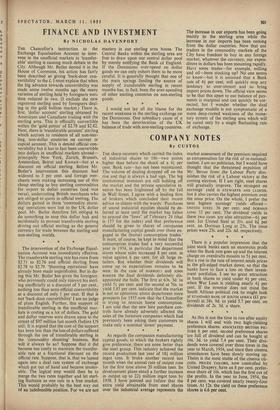COMPANY NOTES
By CUSTOS
THE sharp recovery which carried the index of industrial shares to 186—two points • higher than before the shock of a 41 per cent. Bank rate—has not been maintained. The volume of dealing dropped off on the rise and that is always a bad sign. The big institutional investors are still holding off the market and the private speculative in- vestor has been frightened off by the fall in Wall Street. I agree with a leading firm of brokers which concluded their recent advice to clients with the words: 'Purchases of sound industrial equities should be de- ferred at least until (he market has fallen to around the "lows" of rebruary 24 (that is 177 for the index) and that preference should be given to shares of companies manufacturing capital goods over those en- gaged in the (home) consumption trades.' It must, of course, be kept in mind that the consumption trades had a very successful year in 1954, in particular the department stores whose sales increased 8 per cent. in value against 6 per cent. for all large re- tailers. But whether their dividends will come up to expectations remains to be seen. In the case of HARROD; and JOHN BARKER the final dividends definitely dis- appointed the bulls. The first at 63s. 3d. to yield 51 per cent. and the second at 76s. to yield 5.85 per cent. indicate that the market is not so optimistic about department store prospects for 1955 now that the Chancellor is trying to restrain home consumption. 1 am told that the new hire purchase con- trols have already adversely affected the sales of the furniture companies which had previously been asking their customers to make only a nominal 'down' payment.
As regards the companies manufacturing capital goods, to which the brokers rightly give preference, there are none better than the steel group. This industry achieved the record production last year of 181 million ingot tons. It broke another record last month when the annual rate of output rose for the first time above 20 million tons. Its development plans entail a further increase in output up to 22-1- million ingot tons by 1958. I have pointed out before that the extra yield obtainable from steel shares over the industrial average represents the
market assessment of the premium required as compensation for the risk of re-national- isation. I am no politician, but I would have thought that the threatened expulsion of Mr. Bevan from the Labour Party dim- inishes the risk of a Labour victory at the coming election. If I am right, steel shares will gradually improve. The strongest on earnings' yield is STEWARTS AND LLOYDS, hut it also carries the highest premium over the issue price. On the whole, I prefer the next highest earnings' yields offered-- UNITED STEEL 36 per cent. and DORMAN LONG 32 per cent. The dividend yields in these two cases are also attractive-64 per cent. for United Steel at 31s. and 61 per cent. on Dorman Long at 25s. The issue prices were 25s. and 22s. 6d. respectively.
• • •
There is a popular impression that the joint stock banks earn an enormous profit when the Bank rate goes up and the interest charge on overdrafts mounts to Sf per cent. But a rise in the rate of interest sends prices in the gilt-edged market down, so that the banks have to face a loss on their invest- ment portfolios. I see no great attraction in bank shares to yield under 41 per cent. when War Loan is yielding nearly 41 per cent. If the investor does not mind the South African political risk he might look at STANDARD BANK OF SOUTH AFRICA (£1 pre- ferred) at 38s. 9d. to yield 5.7 per cent, on dividends of 2s. 3d. a share.
As this is not the time to run after equity shares I will end with two high-yielding preference shares. ASSOCIATED BRITISH PIC- TURE 6 per cent. second preference shares are full of dividend and can be bought at 16s. 3d. to yield 7.4 per cent. Their divi- dends were covered over three times in the year to March, 1954, and since then cinema attendances have been slowly moving up. Theirs is the most stable of the cinema cir- cuits. PRICES TAILORS, now controlled by United Drapery, have an 8 per cent, prefer- ence share of 10s. which has the first cut of the profits. In the year to June, 1954, the 8 per cent. was covered nearly twenty-four times. At 12s. the yield on these preference shares is 6.6 per cent.










































 Previous page
Previous page